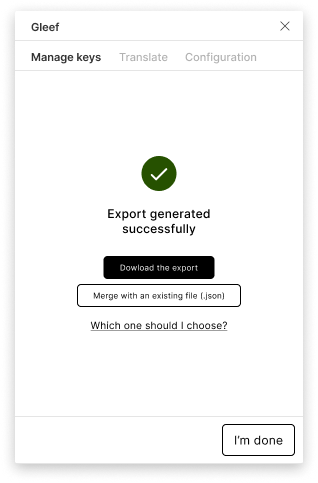How to export translations and localization keys?

- Select one or several frames you want to export translations from.
- Click on the Export button in the Plugin.
- Click on the Download the export button.
- Choose the format you want to export keys in.
How to merge the Gleef translations with my existing content?
- Select one or several frames you want to export translations from.
- Click on the Export
- Click on Merge with existing files
- Select all your existing locale files (all languages). You will get a zip files with your updated localization files!
Export formats
You can choose between 3 main formats, the most commonly used in localization:- CSV
- XML
- JSON
For the JSON and XML formats, you will get a .zip file containing a file per language.
Exporting in CSV
CSV is the most commonly used format when humans are expected to review or edit the content. It is easy to read and write, and can be opened with any spreadsheet software. It can also be imported into all the main localization softwares.Exporting in XML
XML is a markup language that defines a set of rules for encoding documents in a format that is both human-readable and machine-readable. It is often used in localization to export keys in a structured format. Format will be:Exporting in JSON
JSON is a lightweight data-interchange format. It is easy for humans to read and write and easy for machines to parse and generate. It is often used by localization libraries to manage keys in a structured format. You have 2 options here:- Merge with an existing file (.json): If you already have a JSON file with keys, you can merge the keys from the Plugin with the existing file. The Plugin will add the new keys to the existing file, and will not overwrite the existing keys.
- Export as a new file (.json): If you don’t have a JSON file with keys, you can export the keys from the Plugin as a new file. Or if you want to integrate manually these new keys in your current file.